inflation pressure Peugeot Partner Tepee 2016 Owner's Manual
[x] Cancel search | Manufacturer: PEUGEOT, Model Year: 2016, Model line: Partner Tepee, Model: Peugeot Partner Tepee 2016Pages: 296, PDF Size: 10.76 MB
Page 7 of 296

5
Location
exteRIoR
Remote control 18-19
Changing the battery ,
reinitialisation
19
Key
18
Starting
55
Hill start assist
56
Central locking / unlocking
18, 27
Filler cap, fuel tank
161-162
Fuel cut-of
f, Diesel priming
162
AdBlue® additive,
topping up 38-39, 163-168
Wiper blades
190
Door mirrors
1
11
Side repeaters
183
Active City Brake
122-125
Front lamps, foglamps, direction indicators
58-60, 180-183
Headlamp beam height adjustment
60
Changing front bulbs
180-183
Headlamp wash
62, 158
Snow cover
178
Front doors
21
Sliding side doors
22-23
Key
18o
pening the bonnet
154
Child lock
147
T
owing, lifting
191
T
owbar,
swan neck towball
148-151
Parking sesnsors
1
15-116
Reversing camera
1
17
Rear roof flap
26e
mergency control
23
Spare wheel, jack,
changing a wheel, tools
172-177
T
emporary puncture repair kit
171
Inflation, pressures
200
Zenith roof
98-99, 102
Roof bars
103
Rear lamps,
direction indicators
58-59
3rd brake lamp
185
Changing
rear bulbs
180-181, 184-185
Doors, tailgate
23-25
Accessories
152
Dimensions
192-195
Brakes, pads
1
14, 157, 159
e
mergency braking
1
18
ABS,
e
BFD
1
18
ASR, DSC
1
19
g
rip control
120-121
Active City Brake
122-125
T
yres, pressures
200
Snow chains
179
T
yre under-inflation detection
4
1-42
Tyre under-inflation detection with reinitialisation
43-46
Number plate lamps
185
1
oVeRVIeW
Page 37 of 296

+
ABS
Instruments and controls
35Warning lamp isindicatesSolution - action
Power
steering on. a fault with the
system.The vehicle retains conventional steering without
assistance. Have it checked by a P
eugeo T
dealer or a qualified workshop.
Door open
detection on and accompanied
by a message in the
screen. that a door is not
closed correctly.
Check that all of the doors are closed.
ABS remaining on. a fault with the anti-
lock braking system.The vehicle retains conventional braking.
Have it checked by a P
eugeo T dealer or a
qualified workshop.
e
SC flashing.
triggering of the ASR
or DSC regulation.The system optimises traction and improves the
directional stability of the vehicle.
Chapter 5, "Driving safety" section.
remaining on. a fault with the
system.
E.g.: under-inflation
of the tyres.
e
.g.: check the pressure of the tyres.
Have it checked by a P
eugeo T dealer or
a qualified workshop. (Wheel speed sensor,
hydraulic valve block, ...).
u
nder-
inflation on.
The tyre pressure is
too low in or more
wheels.Check the tyre pressure as soon as possible.
This check must be done with the tyres cold.
flashing then
remaining on,
accompanied by the
Service warning
lamp, and depending
on equipment, the
display of a message. The tyre pressure
monitoring system
has a fault or one of
the wheels does not
have a sensor.
Detection of under-inflation is no longer assured.
Have it checked by a P
eugeo T dealer or a
qualified workshop.
Particle filter on. a problem with the
particle filter (fuel
additive level, risk of
blockage,
...).Have the filter checked by a PEUGEOT dealer or
a qualified workshop.
Chapter 7, "Levels" section.
ReADY to go
3
Page 43 of 296
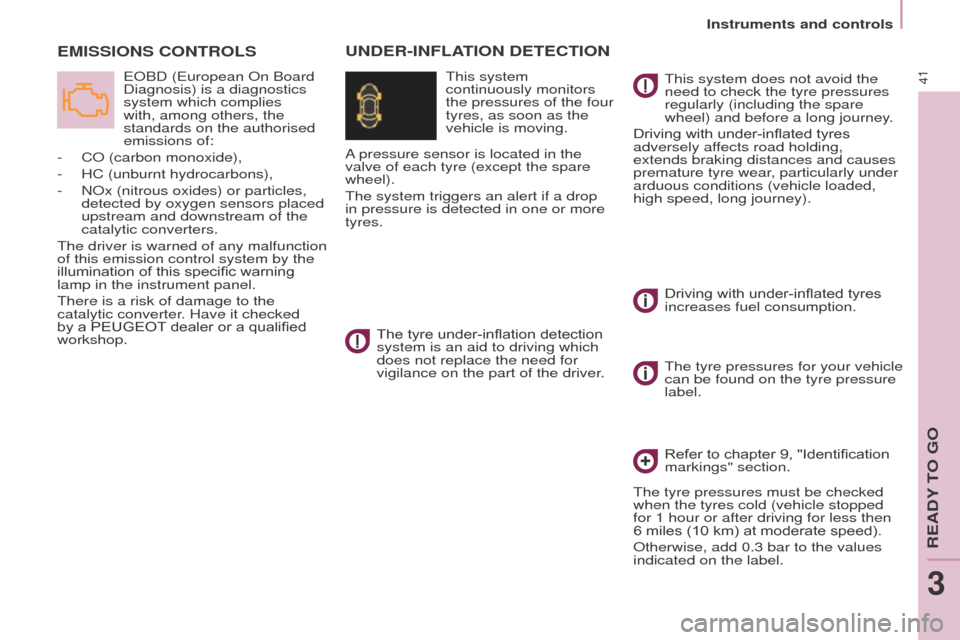
Instruments and controls
41
eMISSIoNS CoNtRoLS
eoBD (european on Board
Diagnosis) is a diagnostics
system which complies
with, among others, the
standards on the authorised
emissions
of:
-
C
o
(carbon monoxide),
-
HC (unburnt hydrocarbons),
-
N
o
x (nitrous oxides) or particles,
detected by oxygen sensors placed
upstream and downstream of the
catalytic converters.
The driver is warned of any malfunction
of this emission control system by the
illumination of this specific warning
lamp in the instrument panel.
There is a risk of damage to the
catalytic converter. Have it checked
by a PEUGEOT dealer or a qualified
workshop.
uNDeR-INFLAt I o N D ete C t I o N
This system
continuously monitors
the pressures of the four
tyres, as soon as the
vehicle is moving.
A pressure sensor is located in the
valve of each tyre (except the spare
wheel).
The system triggers an alert if a drop
in pressure is detected in one or more
tyres.
The tyre under-inflation detection
system is an aid to driving which
does not replace the need for
vigilance on the part of the driver. This system does not avoid the
need to check the tyre pressures
regularly (including the spare
wheel) and before a long journey .
Driving with under-inflated tyres
adversely affects road holding,
extends braking distances and causes
premature tyre wear, particularly under
arduous conditions (vehicle loaded,
high speed, long journey).
Driving with under-inflated tyres
increases fuel consumption.
The tyre pressures for your vehicle
can be found on the tyre pressure
label.
Refer to chapter 9, "Identification
markings" section.
The tyre pressures must be checked
when the tyres cold (vehicle stopped
for 1 hour or after driving for less then
6 miles (10 km) at moderate speed).
o
therwise, add 0.3 bar to the values
indicated on the label.
ReADY to go
3
Page 44 of 296

Instruments and controls
42
The alert is maintained until
the tyre or tyres concerned is
reinflated, repaired or replaced.
The spare wheel (space-saver
type or a steel rim) does not have a
sensor.
operating faultu
nder-inflation alert
The loss of pressure detected
does not always lead to visible
deformation of the tyre. Do not rely
on just a visual check.The alert is given by the fixed
illumination of this warning lamp,
accompanied by an audible signal,
and depending on equipment, the
display of a message.The flashing and then
fixed illumination of the
under-inflation warning
lamp accompanied by the
illumination of the "Service" warning
lamp, and depending on equipment,
the display of a message indicates a
fault with the system.
In this case, monitoring of the tyre
pressures is not assured.
In the event of a problem on one of
the tyres, the symbol or the message
appears, according to equipment, to
identify it.
-
Reduce speed, avoid sudden
steering movements or harsh brake
applications.
-
Stop as soon as it is safe to do so.
-
In the event of a puncture, use
the temporary puncture repair kit
or the spare wheel (according to
equipment),
or
-
if you have a compressor
, the one
in the temporary puncture repair
kit for example, check the four tyre
pressures when cold,
or
-
if it is not possible to check the
tyre pressures at the time, drive
carefully at reduced speed.
This alert is also displayed when
one or more wheels is not fitted
with a sensor (for example, a
space-saver or steel spare wheel).
g
o to a P eugeo T dealer or a
qualified workshop
to have the system
checked or, following the repair of a
puncture, to have the original wheel,
equipped with a sensor, refitted.
Page 45 of 296
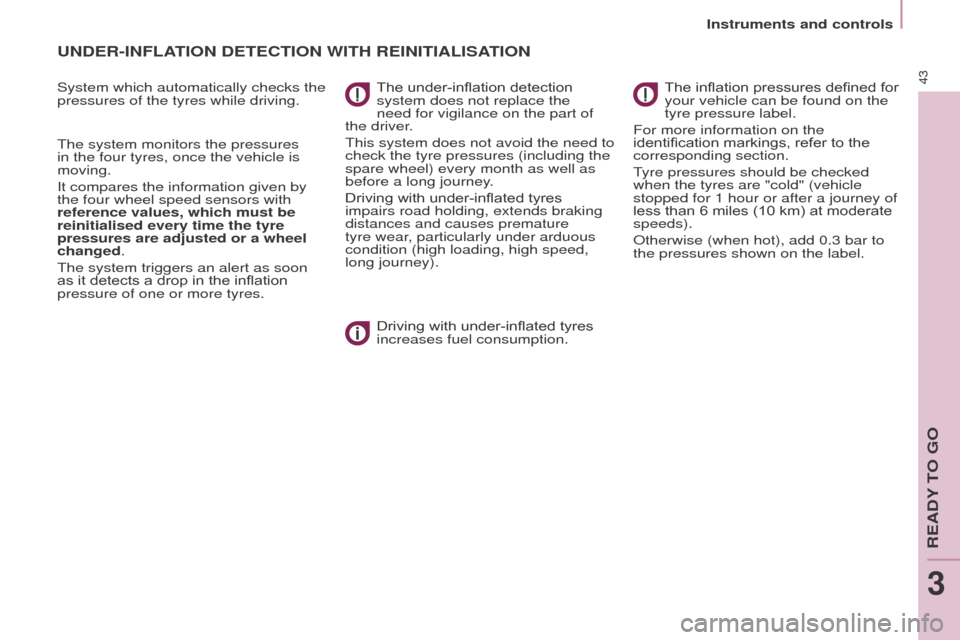
Instruments and controls
43
uNDeR-INFLAtI o N D ete C t I o N WI t H R e INI t IALISAt I o N
System which automatically checks the
pressures of the tyres while driving.
The system monitors the pressures
in the four tyres, once the vehicle is
moving.
It compares the information given by
the four wheel speed sensors with
reference values, which must be
reinitialised every time the tyre
pressures are adjusted or a wheel
changed.
The system triggers an alert as soon
as it detects a drop in the inflation
pressure of one or more tyres.The under-inflation detection
system does not replace the
need for vigilance on the part of
the
driver.
This system does not avoid the need to
check the tyre pressures (including the
spare wheel) every month as well as
before a long journey.
Driving with under-inflated tyres
impairs road holding, extends braking
distances and causes premature
tyre wear, particularly under arduous
condition (high loading, high speed,
long journey).
Driving with under-inflated tyres
increases fuel consumption. The inflation pressures defined for
your vehicle can be found on the
tyre pressure label.
For more information on the
identification markings, refer to the
corresponding section.
Tyre pressures should be checked
when the tyres are "cold" (vehicle
stopped for 1 hour or after a journey of
less than 6 miles (10 km) at moderate
speeds).
o
therwise (when hot), add 0.3 bar to
the pressures shown on the label.
ReADY to go
3
Page 46 of 296
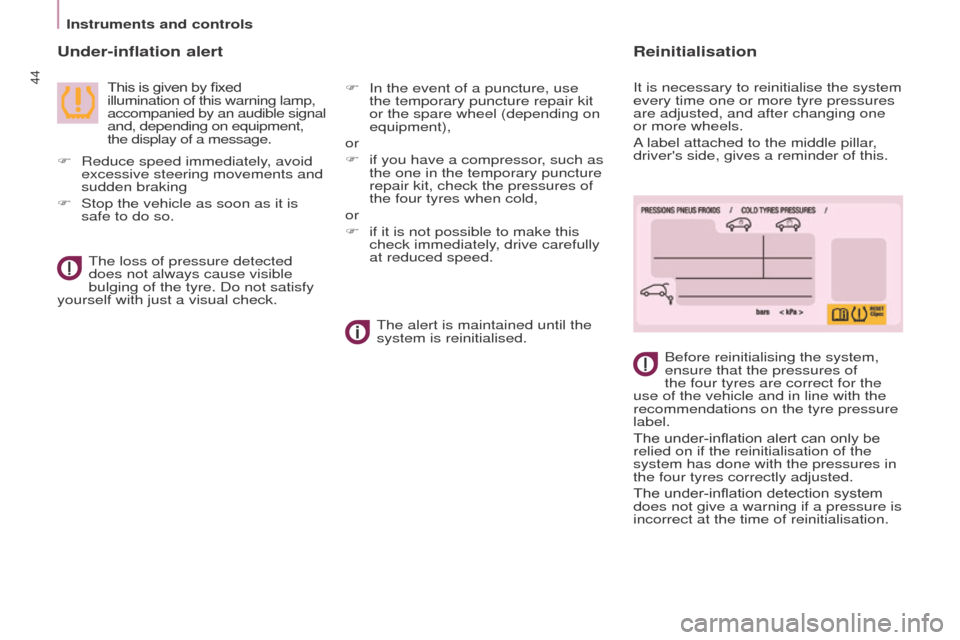
Instruments and controls
44
under-inflation alert
This is given by fixed
illumination of this warning lamp,
accompanied by an audible signal
and, depending on equipment,
the display of a message.Before reinitialising the system,
ensure that the pressures of
the four tyres are correct for the
use of the vehicle and in line with the
recommendations on the tyre pressure
label.
The under-inflation alert can only be
relied on if the reinitialisation of the
system has done with the pressures in
the four tyres correctly adjusted.
The under-inflation detection system
does not give a warning if a pressure is
incorrect at the time of reinitialisation.
The loss of pressure detected
does not always cause visible
bulging of the tyre. Do not satisfy
yourself with just a visual check.
The alert is maintained until the
system is reinitialised.
F
Reduce speed immediately
, avoid
excessive steering movements and
sudden braking
F
Stop the vehicle as soon as it is
safe to do so. F
In the event of a puncture, use
the temporary puncture repair kit
or the spare wheel (depending on
equipment),
or
F
if you have a compressor
, such as
the one in the temporary puncture
repair kit, check the pressures of
the four tyres when cold,
or
F
if it is not possible to make this
check immediately
, drive carefully
at reduced speed.
Reinitialisation
It is necessary to reinitialise the system
every time one or more tyre pressures
are adjusted, and after changing one
or more wheels.
A label attached to the middle pillar,
driver's side, gives a reminder of this.
Page 47 of 296
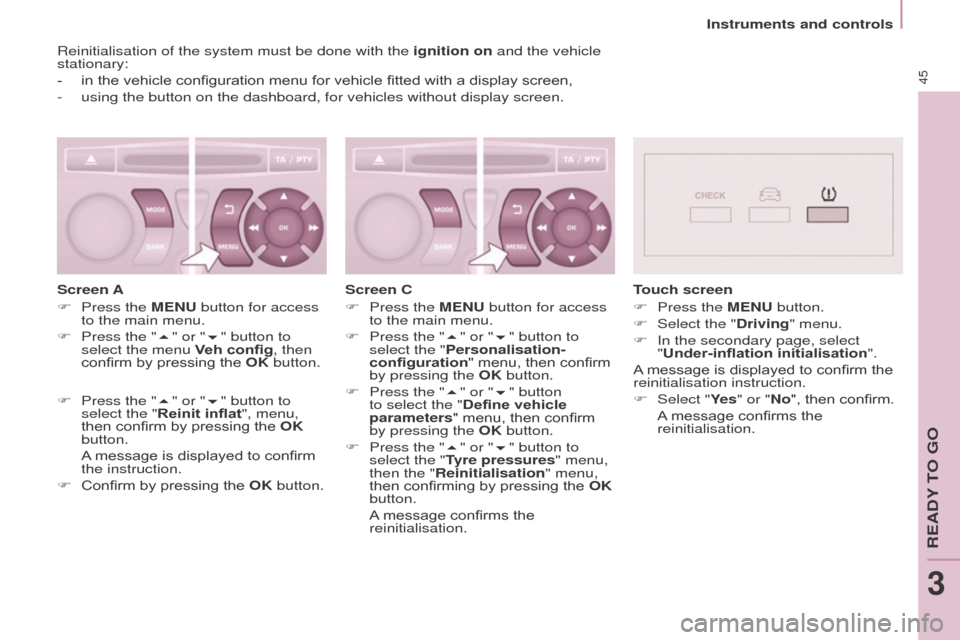
Instruments and controls
45
Reinitialisation of the system must be done with the ignition on and the vehicle
stationary:
-
in the vehicle configuration menu for vehicle fitted with a disp
lay screen,
-
using the button on the dashboard, for vehicles without display screen.
Screen A
F
Press the
M e N u button for access
to the main menu.
F
Press the "
5" or "6" button to
select the menu Veh config, then
confirm by pressing the
o K button.
F
Press the "
5" or "6" button to
select the "Reinit inflat", menu,
then confirm by pressing the
o K
button.
A
message is displayed to confirm
the instruction.
F
Confirm by pressing the
o K button.Screen C
F
Press the
M e N u button for access
to the main menu.
F
Press the "
5" or "6" button to
select the "Personalisation-
configuration" menu, then confirm
by pressing the
o K button.
F
Press the "
5" or "6" button
to select the "Define vehicle
parameters" menu, then confirm
by pressing the
o K button.
F
Press the "
5" or "6" button to
select the "
t
yre pressures
" menu,
then the "Reinitialisation" menu,
then confirming by pressing the
o K
button.
A
message confirms the
reinitialisation.
touch screen
F
Press the
M e N u button.
F
Select the "
Driving" menu.
F
In the secondary page, select
"
Under-inflation initialisation".
A message is displayed to confirm the
reinitialisation instruction.
F
Select "
Ye s" or "No", then confirm.
A
message confirms the
reinitialisation.
ReADY to go
3
Page 48 of 296
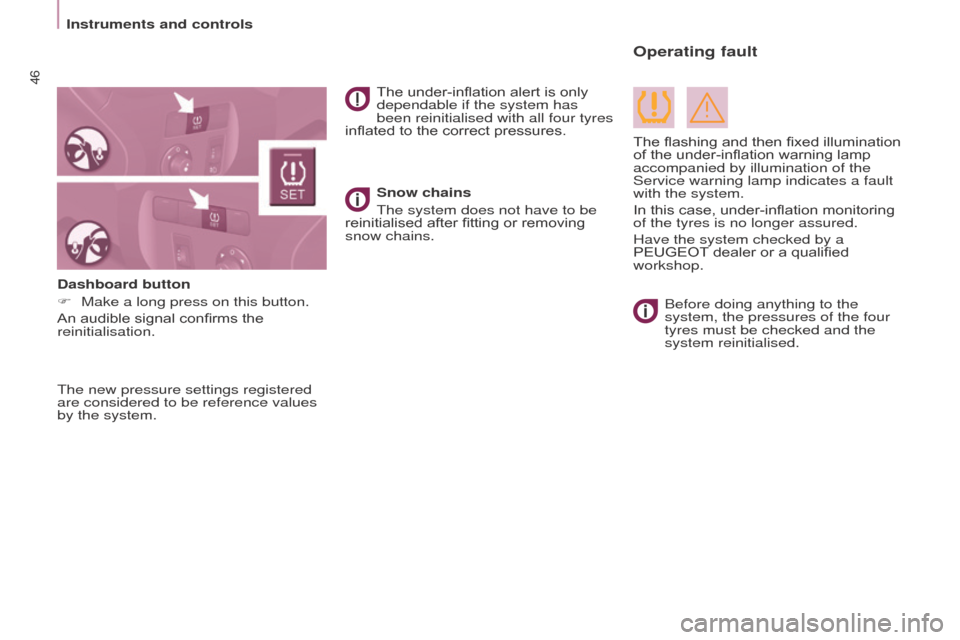
Instruments and controls
46
The new pressure settings registered
are considered to be reference values
by the system.The under-inflation alert is only
dependable if the system has
been reinitialised with all four tyres
inflated to the correct pressures.
Before doing anything to the
system, the pressures of the four
tyres must be checked and the
system reinitialised.
Snow chains
The system does not have to be
reinitialised after fitting or removing
snow chains.
Dashboard button
F
Make a long press on this button.
An audible signal confirms the
reinitialisation.
operating fault
The flashing and then fixed illumination
of the under-inflation warning lamp
accompanied by illumination of the
Service warning lamp indicates a fault
with the system.
In this case, under-inflation monitoring
of the tyres is no longer assured.
Have the system checked by a
PEUGEOT dealer or a qualified
workshop.
Page 178 of 296

176
FIttINg tHe WHeeL tRIM
The tyre valve must be centred in the
wheel trim cut-out.
This position is essential for fitting the
wheel trim correctly on the steel wheel.
(If the valve is not correctly aligned with
the cut-out, the anti-rotation system
will be in contact with the heads of the
wheel bolts and risks being damaged
if the user persists in fitting the wheel
trim in this incorrect position).
-
e nsure that all of the clips are
engaged except the last one
(opposite the valve hole).
-
Strike the wheel trim with the palm
of your hand, opposite the valve
in the area of the last fixing clip
(always in the direction of clipping).
-
e nsure that the outer edge of
the wheel trim is not deformed or
pushed into the wheel:
●
Correct position
for the edge of
the wheel trim.
●
Incorrect position
for the edge
of the wheel trim.
6. Refitting the repaired wheel
The wheel is refitted as described in
step 5, not forgetting to refit the wheel
trim.
Refer to the "Instruments and
controls" section of chapter 3,
"Tyre under-inflation detection"
part, for recommendations after
changing a wheel fitted with a tyre
under-inflation detection sensor. Refer to the "Identification
markings" section of chapter 9 to
locate the tyre label.
The spare wheel is not designed
to be used over long distances.
Have the tightening of the bolts
and the tyre pressure checked by
a PEUGEOT dealer or a qualified
workshop as soon as possible.
Have the original wheel repaired
and refitted by a PEUGEOT dealer
or a qualified workshop as soon as
possible.
Changing a wheel
Page 202 of 296
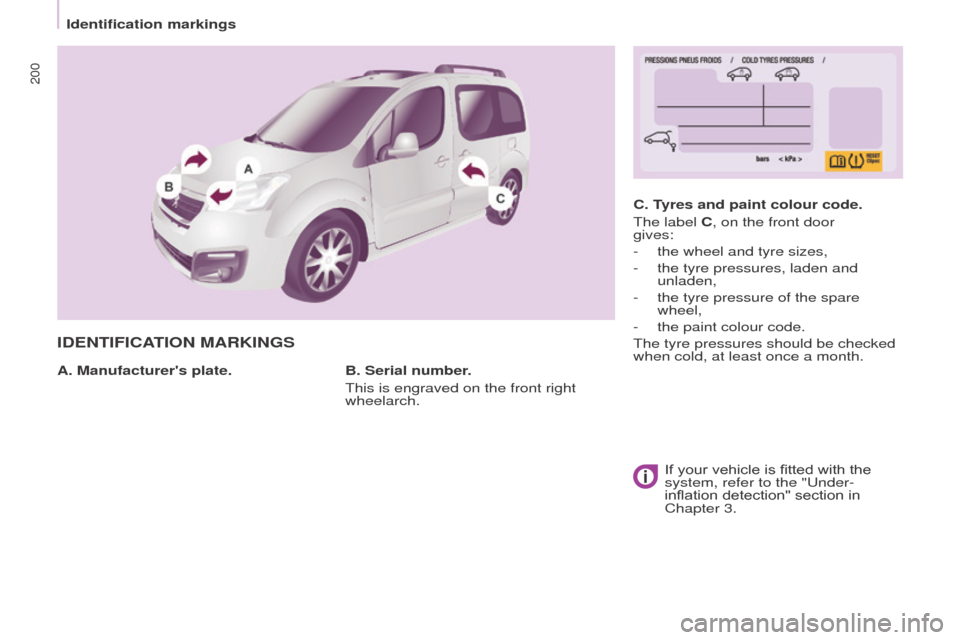
200
IDeNtIFICAtI o N MARKIN g S
A. Manufacturer's plate. C. t
yres and paint colour code.
The label
C, on the front door
gives:
-
the wheel and tyre sizes,
-
the tyre pressures, laden and
unladen,
-
the tyre pressure of the spare
wheel,
-
the paint colour code.
The tyre pressures should be checked
when cold, at least once a month.
B. Serial number
.
This is engraved on the front right
wheelarch.
If your vehicle is fitted with the
system, refer to the "
u nder-
inflation detection" section in
Chapter 3.
Identification markings